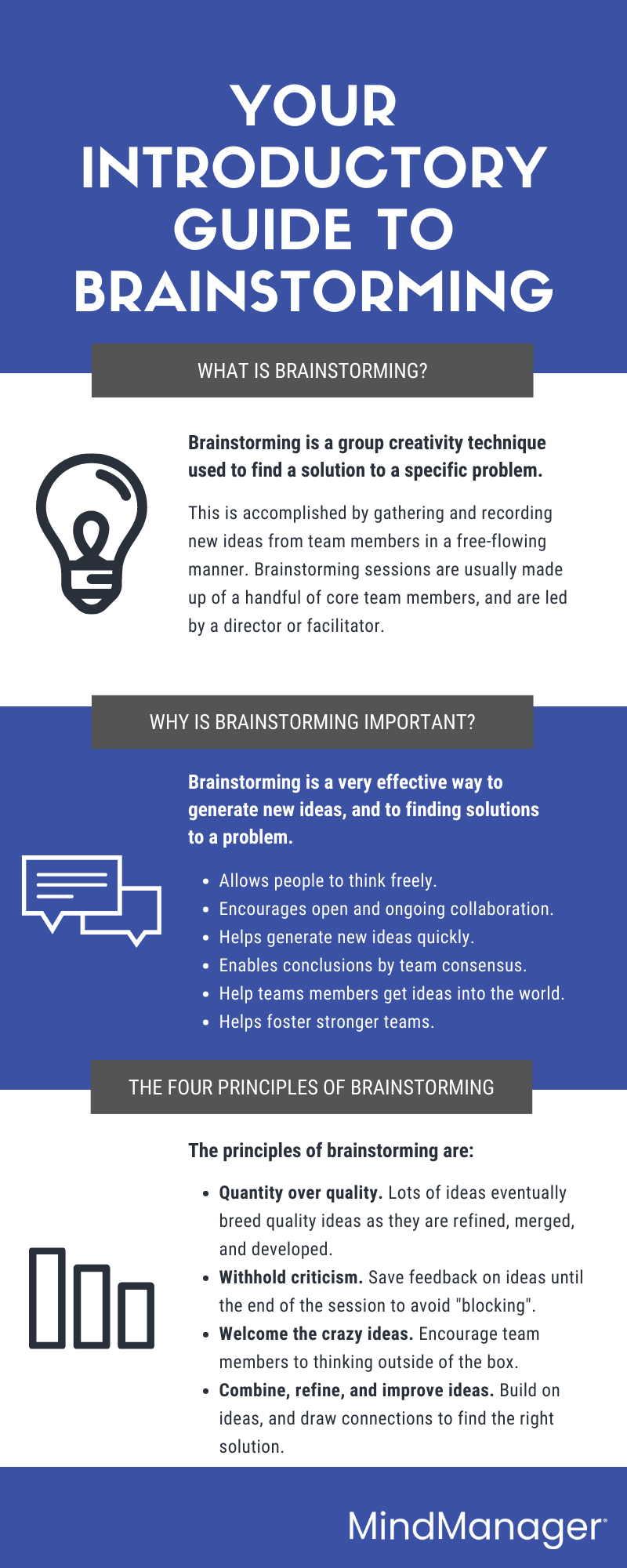Brainstorming is a great technique that business professionals can use to generate new and unique ideas. It’s a term that’s thrown around quite a bit, and is often used interchangeably with other problem solving and idea generation techniques.
Brainstorming has become part of our daily lexicon in business. But what is brainstorming, and why is it an important technique for business professionals?
This article will tackle these two questions, and give you some examples of brainstorming topics or problems that are common in various business settings.

What is brainstorming?
Brainstorming is a group creativity technique that is often used to find a solution to a specific problem. This is accomplished by gathering and recording new ideas from team members in a free-flowing manner.
Brainstorming sessions are usually made up of a handful of core team members, and typically are led by a director or facilitator.
Brainstorming originated from an advertising executive named Alex F. Osborne, and dates back to around 1939. Frustrated with his employees’ inability to generate creative new ideas, Osborne began developing new methods for problem solving that focused on a team-based approach to work.
He began hosting group-thinking sessions, and discovered that this approach led to a significant boost in the quality and quantity of new ideas. Osborne coined these group meetings “brainstorm” sessions, and wrote about the technique in later publications.
During these brainstorming sessions, ideas are collected and recorded using whatever tool is available to the team. Modern businesses have begun to adopt digital brainstorming tools to speed up the process and make the review phases faster and more productive.
Quantity of ideas is usually emphasized over quality, with the goal of generating as many new suggestions as possible. Once all ideas have been collected, the team then evaluates each of them and focuses on the ones that are most likely to solve the problem.
The four principles of brainstorming
While brainstorming has evolved over the years, Osborne’s four underlying principles are a great set of guidelines when running your own sessions. These principles include:
- Quantity over quality. The idea is that quantity will eventually breed quality as ideas are refined, merged, and developed further.
- Withhold criticism. Team members should be free to introduce any and all ideas that come into their heads. Save feedback until after the idea collection phase so that “blocking” does not occur.
- Welcome the crazy ideas. Encouraging your team members to think outside of the box, and introduce pie in the sky ideas opens the door to new and innovative techniques that may be your ticket for success.
- Combine, refine, and improve ideas. Build on ideas, and draw connections between different suggestions to further the problem solving process.
Brainstorming techniques and processes helps your team innovate and work collaboratively. There’s no single right way to hold a brainstorming session. In fact, holding individual or reverse brainstorming sessions can both be helpful activities for generating new ideas.
Your goal should always be to use the process that works best for you and your team.
Eight reasons why brainstorming is important?
If you’ve ever held a brainstorming session, you likely know that they can be very effective for generating new ideas, and finding solutions to a problem. This is largely due to the many advantages of brainstorming that help teams work more collaboratively towards a common goal.
Some of the advantages of brainstorming for businesses and individual productivity include:
- Brainstorming allows people to think more freely, without fear of judgment.
- Brainstorming encourages open and ongoing collaboration to solve problems and generate innovative ideas.
- Brainstorming helps teams generate a large number of ideas quickly, which can be refined and merged to create the ideal solution.
- Brainstorming allows teams to reach conclusions by consensus, leading to a more well-rounded and better informed path forward.
- Brainstorming helps team members feel more comfortable bouncing ideas off one another, even outside of a structured session.
- Brainstorming introduces different perspectives, and opens the door to out-of-the-box innovations.
- Brainstorming helps team members get ideas out of their heads and into the world, where they can be expanded upon, refined, and put into action.
- Brainstorming is great for team building. No one person has ownership over the results, enabling an absolute team effort.
In summary, the core advantages of brainstorming are its ability to unlock creativity by collaboration. It’s the perfect technique to use for coming together as a team, and can help to generate exciting new ideas that can take your business to a new level.
Now that we’ve established what brainstorming is, and why it’s important, let’s take a look at some examples of scenarios where it would be useful.
Examples of when to use brainstorming
As you can probably guess, brainstorming is a technique that can be used in a wide variety of different situations. It can be in both your personal and professional life to help you find new ideas and solutions to different problems you’re working on.
Because of this versatility, brainstorming is a widely used technique among companies and teams of all sizes.
To get you thinking about where you can use brainstorming, here are some examples of scenarios when this technique might be useful.
Scenario #1
Your content and product marketing teams need to generate new messaging ideas for an upcoming product launch. You have a set of new features that you know will be exciting for your users, but you’re struggling to find the right words to convey their importance and benefits.
Calling a brainstorming session to generate new messaging ideas would be a perfect way to start this writing process. As a team, you can throw as many ideas and slogans together as you can, and then refine them together to get a clear picture of the direction going forward.
Scenario #2
You’ve been tasked by your executive team to come up with a growth strategy for the coming fiscal year, which focuses on expanding your footprint into your most successful markets. You know that there is room for growth, but aren’t sure which areas to focus on.
Gathering the key stakeholders in your department and across the organization for a brainstorming session will help you quickly gather a list of growth opportunities. Each team member will have their own ideas for growth within their role which can be added to a longer list of strategic possibilities.
Scenario #3
Your product development team has been repeatedly running into an issue with a new version of your software. Because of the complexity of the project, it’s difficult to tell what the root cause of the problem might be.
Calling your product team together for a brainstorming session will help you gather opinions on what the issue might be. As more theories come forth, it’s likely that a consensus will start to form about where the core issue lies. From there, you can brainstorm ways to fix the problem.
These are just three high level examples of brainstorming. This technique is incredibly versatile, and can be applied to virtually any problem or goal that your business needs to address.
The advantages of brainstorming are many, and we highly recommend that you start to incorporate it more throughout your business operations.
MindManager® is an innovative visual productivity solution that offers a variety of pre-built templates to help you visualize projects more effectively, including Kanban boards, Gantt charts, Flowcharts, and more.
Download a free trial of MindManager today to get started with brainstorming!

